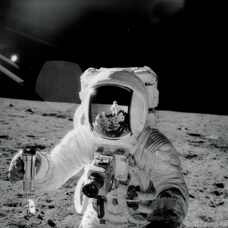 When
astronauts brought back samples of the moon during the Apollo missions,
they also brought back soils bearing a high amount of nitrogen relative to other
volatile elements. So far, neither solar wind nor meteorites seem to fully explain
the nitrogen ions. New examinations of lunar soil samples have led researchers
to suggest that the nitrogen arrived on the moon from Earth’s atmosphere
before the planet’s magnetic field was in place.
When
astronauts brought back samples of the moon during the Apollo missions,
they also brought back soils bearing a high amount of nitrogen relative to other
volatile elements. So far, neither solar wind nor meteorites seem to fully explain
the nitrogen ions. New examinations of lunar soil samples have led researchers
to suggest that the nitrogen arrived on the moon from Earth’s atmosphere
before the planet’s magnetic field was in place. Apollo astronauts brought back samples of soil from the moon that contained unexpectedly high levels of nitrogen. New research is shedding light on the anomaly. Courtesy of NASA.
Earth’s geodynamo — the electric currents generating the planet’s magnetic field, stoked by flowing molten metals in the core — currently shields the atmosphere, preventing the solar wind from picking off its volatile elements. But before the geodynamo existed, the elements could have escaped more easily and landed on the Earthward side of the moon.
A group of researchers led by Minoru Ozima of the University of Tokyo suggests in the Aug. 4 Nature that scientists could examine soil samples on the far side of the moon to test that idea. The team points out that the moon most likely became fixed in its orientation relative to Earth immediately after it formed. Therefore, lunar samples from the far side would have less nitrogen in their gas signatures than samples from the near side — which presumably was bombarded more heavily by Earth-atmosphere ions until the planetary geodynamo began.
David Stevenson, a geophysicist at Caltech in Pasadena, Calif., says the team’s suggestion to test the far side of the moon “makes a possible fascinating connection between what happened on the moon and the early Earth,” furthered by a “nice argument” using observations by the Pioneer Venus Orbiter. The orbiter observed elements escaping from Venus’ atmosphere at rates that would produce similar amounts as found in the Apollo soil samples. Because Venus lacks its own geodynamo, its current ion-loss levels could be similar to those that might have occurred around 4 billion years ago on Earth, the researchers argue.
In general, geophysicists do not know when the geodynamo began on Earth, as they have had to rely on models and magnetic data from rocks that have survived through time, Stevenson says. (Earth’s oldest known rocks are 4.03 billion years old, on a planet that is at least 4.54 billion years old.) If the source of the moon’s nitrogen were from early Earth, nailing down the start of the geodynamo might be possible.
“The most important problem is solving where the nitrogen comes from,” says Frank Podosek of Washington University in St. Louis, Mo., who is a co-author of the new work, particularly in order to put to rest uncertainty about the sun’s behavior. If the nitrogen did not come from Earth’s atmosphere, and instead from the solar wind, he says, “then it remains possible that there’s something that happens in the sun that we don’t understand.” The moon’s nitrogen levels are too high to account for solar wind contributions, given current models of the sun. Podosek says that by the end of the year, the team will test several lunar meteorites that are presumed to be from the far side of the moon.
Looking at nitrogen ratios currently streaming in the solar wind would also help address the quandary, and the Genesis mission that crash-landed a year ago in the Utah desert should yield that information. The nitrogen ratio should be “significantly” different than that of Earth’s atmosphere, says Don Burnett of Caltech, who led the Genesis mission. If so, and if Ozima’s team finds higher ratios of nitrogen on the Earthward side of the moon, that points to Earth as the major contributor of the moon’s ions. If not, then scientists may have to go back to the drawing board to figure out what the original solar system was made of and how it formed.

